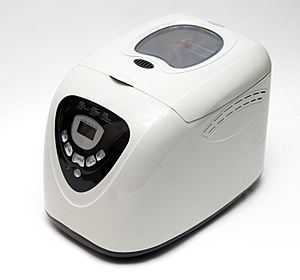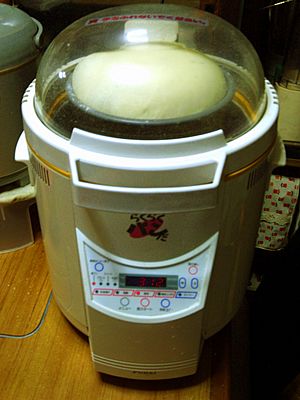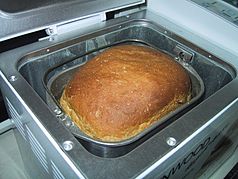Bread machine facts for kids
A bread machine or breadmaker is a cool home appliance that helps you make fresh bread right at home! It takes simple ingredients and turns them into a delicious baked loaf. Inside, there's a special bread pan with one or more paddles at the bottom. This pan sits in a small oven, which is controlled by a tiny computer. You use a control panel to tell the machine what to do. Most bread machines have different settings for various types of dough, like white bread, whole grain, or even just dough for pizza. Many also have a timer, so you can set it to start baking later, even when you're not around. Some fancy models even let you create your own custom baking plan!
Contents
How did bread machines start?
Big bread machines for factories had been around for a long time. But the first breadmaker made for homes came out in Japan in 1986. It was created by the Matsushita Electric Industrial Co., which is now called Panasonic. A team of engineers and a software developer named Ikuko Tanaka worked on it. Ikuko even trained with a master baker to learn the best way to knead bread!
About ten years later, these machines became very popular in places like the United Kingdom, Australia, and the United States. Bread machines are great for making bread at home. They work best with doughs that need a lot of kneading.
How do you use a bread machine?
To make a loaf of bread, you first measure your ingredients. You usually put liquids in first, then add the dry ingredients on top. This order is important because the yeast used in breadmakers starts working when it touches water. So, you want to keep the yeast and water separate until the machine begins.
The machine takes a few hours to make a loaf. First, the ingredients rest and warm up to the right temperature. Then, the paddles mix everything into a dough. The dough then rises in a warm, controlled environment. Finally, it bakes!
What does the bread look like?
Once the bread is baked, you take the pan out of the machine. You'll see a small hole or dent where the paddle was. Early bread machines often made tall, square, or round loaves that looked different from store-bought bread. But newer machines often have a more traditional horizontal pan, making loaves that look more familiar. Some machines even have two paddles for better mixing. One Zojirushi model even has a heating element in the lid to make the crust extra brown!
What ingredients can you use?
Recipes for bread machines are often a bit smaller than regular bread recipes. Many recipes are made for machines that hold 1.5 pounds (700 grams) of bread. However, 2-pound (900-gram) machines are also common. You can even buy special packaged bread mixes just for breadmakers. These mixes have all the ingredients, like flour and yeast, already measured out. You usually just need to add water!
Bread machines don't always work well with flours that don't have much gluten, like rye or corn flour. Also, doughs with a lot of liquid, like ciabatta, can be tricky.
Homemade bread usually goes stale faster than bread from a store. This is because homemade bread doesn't have preservatives. But you can use a natural starter or a pre-ferment in your bread machine recipes. These can help preserve the bread and add flavor.
What else can bread machines do?
Many breadmakers have a timer. This is super handy because you can load the ingredients at night and set the machine to start baking early in the morning. That way, you wake up to fresh, warm bread for breakfast!
Some machines can also be set to make only dough, which is perfect for pizza. Others can make different things like jam, pasta dough, udon noodles, or even mochi (a Japanese rice cake). Some newer machines can even add nuts and fruit automatically during the kneading process from a special tray.
Most breadmakers take about three to four hours to bake a loaf. But many now have "fast bake" modes that can make bread in under an hour. The bread might not be quite as good as a loaf made with a longer program, but it's a great feature when you're in a hurry!
Horizontal vs. Vertical Loaves
In the 1990s, some breadmakers made tall, vertical loaves, while others made flatter, horizontal ones. Today, most machines you buy make horizontal loaves. These loaves are often shorter than the vertical ones. It can be harder for the machine to mix a long, horizontal loaf. Some machines use two paddles to help with this. Vertical loaf machines might need a stronger motor because the whole dough ball sits on the paddle as it mixes. A vertical loaf also gives you slices that are the same size from one end of the loaf to the other.
Most of the best bread machines have a "cold wall." This means the outside surface doesn't get too hot while the bread is baking, making them safer to touch.
See also
 In Spanish: Máquina panificadora para niños
In Spanish: Máquina panificadora para niños





